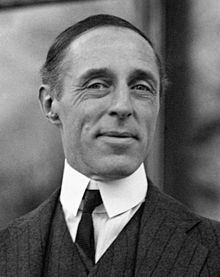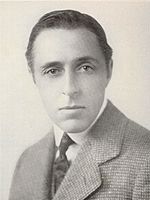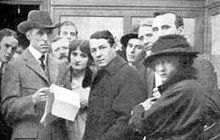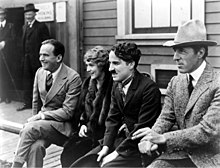D. W. Griffith
D. W. Griffith | |
|---|---|
 Griffith in 1922 | |
| Born | David Wark Griffith January 22, 1875 Oldham County, Kentucky, U.S. |
| Died | July 23, 1948 (aged 73) Hollywood, California, U.S. |
| Resting place | Mount Tabor Methodist Church Graveyard, Centerfield, Kentucky, U.S. |
| Occupations |
|
| Years active | 1895–1931 |
| Spouses | |
| Signature | |
David Wark Griffith (January 22, 1875 – July 23, 1948) was an American film director. Considered one of the most influential figures in the history of the motion picture,[2] he pioneered many aspects of film editing[3] and expanded the art of the narrative film.[4]
To modern audiences, Griffith is known primarily for directing the 1915 film The Birth of a Nation. One of the most financially successful films of all time and considered a landmark by film historians, it has attracted much controversy for its degrading portrayals of African Americans, its glorification of the Ku Klux Klan, and support for the Confederacy. The film led to riots in several major cities all over the United States and the NAACP attempted to have it banned. Griffith made his next film Intolerance (1916) as an answer to critics, who he felt unfairly maligned his work.
Together with Charlie Chaplin, Mary Pickford, and Douglas Fairbanks, Griffith founded the studio United Artists in 1919 with the goal of enabling actors and directors to make films on their own terms, as opposed to the terms of commercial studios. Several of Griffith's later films were successful, including Broken Blossoms (1919), Way Down East (1920), and Orphans of the Storm (1921), but the high costs he incurred for production and promotion often led to commercial failure. He had made roughly 500 films by the time of The Struggle (1931), his final feature, and all but three were completely silent.
Early life
[edit]
Griffith was born on January 22, 1875,[5] on a farm in Oldham County, Kentucky, the son of Jacob Wark "Roaring Jake" Griffith,[6] a Confederate Army colonel in the American Civil War who was elected as a Kentucky state legislator, and Mary Perkins (née Oglesby).[5] Griffith was raised as a Methodist,[7] and he attended a one-room schoolhouse, where he was taught by his older sister Mattie. His father died when he was 10, and the family struggled with poverty.
When Griffith was 14, his mother abandoned the farm and moved the family to Louisville, Kentucky; there she opened a boarding house, which was unsuccessful. Griffith then left high school to help support the family, taking a job in a dry goods store and later in a bookstore. He began his creative career as an actor in touring companies. Meanwhile, he was learning how to become a playwright, but he had little success. Only one of his plays was accepted for a performance.[8] He traveled to New York City in 1907 in an attempt to sell a script to Edison Studios producer Edwin Porter;[8] although Porter rejected the script, he gave Griffith an acting part in Rescued from an Eagle's Nest instead.[8] As a result of this experience, Griffith decided to try his luck as an actor, and he appeared in many films as an extra.[9]
Early film career
[edit]
In 1908, Griffith accepted a role as a stage extra in Professional Jealousy for the American Mutoscope and Biograph Company, where he met cameraman Billy Bitzer.[10] In 1908, Biograph's main director Wallace McCutcheon Sr. fell ill, and his son Wallace McCutcheon Jr. took his place.[11] McCutcheon Jr. did not bring the studio success;[10] Biograph co-founder Harry Marvin then gave Griffith the position,[10] and he made the short The Adventures of Dollie. He directed a total of 48 shorts for the company that year.
Among the films he directed in 1909 was The Cricket on the Hearth, an adaptation of Charles Dickens' novel. Showing the influence of Dickens on his own film narrative, Griffith employed the technique of cross-cutting—where two stories run alongside each other, as seen in Dickens' novels such as Oliver Twist.[12] When criticized by a cameraman for doing this technique in a later film, Griffith was said to have replied "Well, doesn't Dickens write that way?".[12]
His short In Old California (1910) was the first film shot in Hollywood, California. Four years later, he produced and directed his first feature film Judith of Bethulia (1914), one of the early films to be produced in the U.S. Biograph believed that longer features were not viable at this point. According to Lillian Gish, the company thought that "a movie that long would hurt [the audience's] eyes".[13]

Griffith left Biograph because of company resistance to his goals and his cost overruns on the film. He took his company of actors with him and joined the Mutual Film Corporation. There he co-produced The Life of General Villa, a silent biographical-action movie starring Pancho Villa as himself, shot on location in Mexico during a civil war. He formed a studio with Majestic Studios manager Harry Aitken,[14] which became known as Reliance-Majestic Studios and later was renamed Fine Arts Studios.[15] His new production company became an autonomous production unit partner in the Triangle Film Corporation along with Thomas H. Ince and Keystone Studios' Mack Sennett. The Triangle Film Corporation was headed by Aitken, who was released from the Mutual Film Corporation,[14] and his brother Roy.
Griffith directed and produced The Clansman through Reliance-Majestic Studios in 1915. The film later became known as The Birth of a Nation. It is one of the early feature length American films.[16] The film was a success, but its depiction of slavery, the Ku Klux Klan, race relations in the American Civil War, and the Reconstruction era of the United States aroused much controversy. It was based on Thomas Dixon Jr.'s 1905 novel The Clansman: A Historical Romance of the Ku Klux Klan, which casts Southern slavery as benign, the enfranchisement of freedmen as a corrupt plot by the Republican Party, and the Ku Klux Klan as a band of heroes restoring the rightful order. This view of the era was popular at the time and was endorsed for decades by historians of the Dunning School, but it met with strong criticism from the National Association for the Advancement of Colored People (NAACP) and other groups.[17][18]
The NAACP attempted to stop showings of the film. This ban was successful in some cities, but nonetheless it was shown widely and became the most successful box-office attraction of its time. It is considered among the first "blockbuster" motion pictures, and it broke all box-office records that had been established until then. "They lost track of the money it made", Lillian Gish remarked in a Kevin Brownlow interview.[19]

Audiences in some major northern cities rioted over the film's racial content and the violence.[20] Griffith's indignation at efforts to censor or ban the film motivated him the following year to produce Intolerance, in which he portrayed the effects of intolerance in four different historical periods: the Fall of Babylon; the Crucifixion of Jesus; the events surrounding the St. Bartholomew's Day massacre (during religious persecution of French Huguenots); and a modern story. Intolerance was not a financial success; it did not bring in enough profits to cover the lavish road show that accompanied it.[21] Griffith put a huge budget into the film's production that could not be recovered in its box office.[22] He mostly financed Intolerance himself, which contributed to his financial ruin for the rest of his life.[23]

Griffith's production partnership was dissolved in 1917, and he went to Artcraft, part of Paramount Pictures, and then to First National Pictures (1919–1920). At the same time, he founded United Artists together with Charlie Chaplin, Mary Pickford, and Douglas Fairbanks; the studio was based on allowing actors to control their own interests rather than being dependent upon commercial studios.[24][25]

He continued to make films, but he never again achieved box-office grosses as high as either The Birth of a Nation or Intolerance.[26]
Later film career
[edit]Although United Artists survived as a company, Griffith's association with it was short-lived. While some of his later films did well at the box office, commercial success often eluded him. Griffith features from this period include Broken Blossoms (1919), Way Down East (1920), Orphans of the Storm (1921), Dream Street (1921), One Exciting Night (1922), The White Rose (1923), America (1924) and Isn't Life Wonderful (1924). Of these, the first three were successes at the box office.[27] Griffith was forced to leave United Artists after Isn't Life Wonderful (1924) failed at the box office.

He made Lady of the Pavements (1929), a part sound film, and only two full-sound films: Abraham Lincoln (1930) and The Struggle (1931). Neither was successful, and after The Struggle, he never made another film.
In 1936, director Woody Van Dyke, who had worked as Griffith's apprentice on Intolerance, asked Griffith to help him shoot the famous earthquake sequence for San Francisco, but Griffith was not given any film credit. Starring Clark Gable, Jeanette MacDonald and Spencer Tracy, it was the top-grossing film of the year.[28]
In 1939, the producer Hal Roach hired Griffith to produce Of Mice and Men (1939) and One Million B.C. (1940). He wrote to Griffith: "I need help from the production side to select the proper writers, cast, et cetera, and to help me generally in the supervision of these pictures."[29]
Although Griffith eventually disagreed with Roach over the production and departed, Roach later insisted that some of the scenes in the completed film were directed by Griffith. This movie was the final production in which Griffith was involved. However, cast members' accounts recall Griffith directing only the screen tests and costume tests. When Roach advertised the film in late 1939 with Griffith listed as producer, Griffith asked that his name be removed.[30]
Griffith was for decades held in awe by many members of the film industry. He was presented with an honorary Oscar by the Academy of Motion Picture Arts and Sciences in 1936.[31] In 1946, he made an impromptu visit to the film location of David O. Selznick's epic western Duel in the Sun, where some of his veteran actors—Lillian Gish, Lionel Barrymore and Harry Carey—were cast members. Gish and Barrymore found their mentor's presence distracting, and they became self-conscious; in response, Griffith hid behind the scenery when the two were filming their scenes.[32]
Death
[edit]On the morning of July 23, 1948, Griffith was discovered unconscious in the lobby at the Knickerbocker Hotel in Los Angeles, where he had been living alone. He died of a cerebral hemorrhage at 3:42 PM on the way to a Hollywood hospital.[24] A public memorial service was held in his honor at the Hollywood Masonic Temple. He is buried at Mount Tabor Methodist Church Graveyard in Centerfield, Kentucky.[33] In 1950, The Directors Guild of America provided a stone and bronze monument for his grave site.[34]
Legacy
[edit]
Griffith has a controversial legacy. Despite criticism, he was a widely celebrated and respected public figure during his life, and modern film historians continue to recognize him for his contributions to the craft of filmmaking. Nevertheless, many critics during his lifetime, as well as in the decades since his death, have characterized him and his work (most notably The Birth of a Nation) as upholding white supremacist ideals. Historians frequently cite The Birth of a Nation as a major factor in the KKK's revival in the 20th century, and it remains controversial to this day.
Performer and director Charlie Chaplin called Griffith "The Teacher of Us All". Filmmakers such as Alfred Hitchcock,[36] Lev Kuleshov,[37] Jean Renoir,[38] Cecil B. DeMille,[39] King Vidor,[40] Victor Fleming,[41] Raoul Walsh,[42] Carl Theodor Dreyer,[43] and Stanley Kubrick have praised Griffith.[44] Sergei Eisenstein expressed his admiration for Griffith as an "outstanding master", but criticized Birth of a Nation, calling it "disgraceful propaganda of racial hatred towards the colored people".[45]

Griffith seems to have been of the first to understand how certain film techniques could be used to create an expressive language; it gained popular recognition with the release of his The Birth of a Nation (1915). His early shorts —such as Biograph's The Musketeers of Pig Alley (1912), show that Griffith's attention to camera placement and lighting heightened mood and tension. In making Intolerance, Griffith opened new possibilities for the medium, creating a form that seems to owe more to music than to traditional narrative.[46][47]
- In the 1951 Philco Television Playhouse episode "The Birth of the Movies", events from Griffith's film career were depicted. Griffith was played by John Newland.
- In 1953 the Directors Guild of America (DGA) instituted the D. W. Griffith Award, its highest honor. However, on December 15, 1999, then DGA President Jack Shea and the DGA National Board announced that the award would be renamed as the "DGA Lifetime Achievement Award". They stated that, although Griffith was extremely talented, they felt his film The Birth of a Nation had "helped foster intolerable racial stereotypes", and that it was thus better not to have the top award in his name.
- On February 8, 1960, Griffith was posthumously awarded a star on the Hollywood Walk of Fame, which is located at 6535 Hollywood Boulevard.[48]
- In 1975, Griffith was honored on a 10-cent postage stamp by the United States.[35]
- The 1976 American comedy film Nickelodeon in part pays homage to silent film makers, and includes footage from The Birth of a Nation.
- D.W. Griffith Middle School in Los Angeles is named after Griffith.[49]
- In 2008 the Hollywood Heritage Museum hosted a screening of Griffith's early films to commemorate the centennial of his start in film.[50]
- On January 22, 2009, the Oldham History Center in La Grange, Kentucky, opened a 15-seat theatre in Griffith's honor. The theatre features a library of available Griffith films.
- In 2024, East West Players in Los Angeles produced Unbroken Blossoms, a world premier play by Philip W. Chung about the making of Broken Blossoms. Griffith was portrayed by actor Arye Gross.[51]
Film preservation
[edit]Griffith has six films preserved on the United States National Film Registry deemed as being "culturally, historically, or aesthetically significant": Lady Helen's Escapade, A Corner in Wheat (both 1909), The Musketeers of Pig Alley (1912), The Birth of a Nation (1915), Intolerance (1916) and Broken Blossoms (1919).
See also
[edit]- D. W. Griffith filmography
- D. W. Griffith House
- Griffith Ranch (in San Fernando, California)
- List of film directors who studied under D. W. Griffith
- List of Freemasons
- List of people from the Louisville metropolitan area
References
[edit]- ^ a b UPI (July 23, 1948) "D.W. Griffith, 73, film pioneer, dies". United Press. Retrieved January 11, 2021.
- ^ D.W. Griffith.
- ^ "Changes in Film Style in the 1910s | wcftr.commarts.wisc.edu". Archived from the original on November 21, 2021. Retrieved November 21, 2021.
- ^ "The Beginnings of Film Narrative" (PDF). University of California Press. Retrieved January 25, 2023.
- ^ a b Kenneth, Dennis (2001). "Griffith, David Wark". In Kleber, John E. (ed.). The Encyclopedia of Louisville. Lexington, Ky.: University Press of Kentucky. p. 359. ISBN 9780813121000.
- ^ "D.W. Griffith (1875–1948)". Retrieved December 3, 2016.
- ^ Blizek, William L. (2009). The Continuum Companion to Religion and Film. A&C Black. p. 126. ISBN 978-0-8264-9991-2.
- ^ a b c "D.W. Griffith". Spartacus-Educational.com. Archived from the original on June 5, 2011. Retrieved February 27, 2019.
- ^ "American Experience | Mary Pickford". Public Broadcasting Service. Retrieved June 5, 2011.
- ^ a b c "D.W. Griffith Biography". Starpulse.com. July 23, 1948. Archived from the original on August 30, 2008. Retrieved June 5, 2011.
- ^ "Who's Who of Victorian Cinema". Victorian-cinema.net. Retrieved June 5, 2011.
- ^ a b "Dickens on screen: the highs and the lows". The Guardian. December 23, 2011. Retrieved April 21, 2020.
- ^ Kirsner, Scott (2008). Inventing the movies: Hollywood's epic battle between innovation and the status quo, from Thomas Edison to Steve Jobs (1st ed.). [s.l.]: CinemaTech Books. p. 13. ISBN 978-1-4382-0999-9.
- ^ a b "D.W. Griffith: Hollywood Independent". Cobbles.com. June 26, 1917. Retrieved June 5, 2011.
- ^ "Fine Arts Studio". Employees.oxy.edu. June 9, 1917. Archived from the original on May 14, 2011. Retrieved June 5, 2011.
- ^ Devore, Dan. "Birth of a Nation, The (1915)", Movie Justice Movie Review, January 23, 2003. Internet Archive Wayback Machine. Retrieved August 4, 2020.
- ^ "'The Birth of a Nation': When Hollywood Glorified the KKK". HistoryNet. June 12, 2006. Retrieved February 27, 2016.
- ^ Brooks, Xan (July 29, 2013). "The Birth of a Nation: a gripping masterpiece … and a stain on history". The Guardian. ISSN 0261-3077. Retrieved February 27, 2016.
- ^ Interview with Lillian Gish in the "Pioneers" episode of the series Hollywood, directed by Kevin Brownlow and David Gill, Thames Television, 1980
- ^ "The Rise and Fall of Jim Crow". PBS. March 21, 1915. Retrieved June 5, 2011.
- ^ "Griffith's 20 Year Record". Cinemaweb.com. September 5, 1928. Archived from the original on July 12, 2011. Retrieved June 5, 2011.
- ^ "Intolerance Movie Review". Contactmusic.com. May 29, 2011. Retrieved June 5, 2011.
- ^ Georges Sadoul (1972 [1965]). Dictionary of Films, P. Morris, ed. & trans., p. 158. UCP.
- ^ a b "DAVID W. GRIFFITH, FILM PIONEER, DIES; Producer of 'Birth of Nation,' 'Intolerance' and 'America' Made Nearly 500 Pictures SET, SCREEN STANDARDS Co-Founder of United Artists Gave Mary Pickford and Fairbanks Their Starts". The New York Times. July 24, 1948. ProQuest 108102777.
- ^ Woo, Elaine (September 29, 2011). "Mo Rothman dies at 92; found new audience for Chaplin". Los Angeles Times. Retrieved October 1, 2011.
- ^ "American Masters. D.W. Griffith". PBS. December 29, 1998. Archived from the original on October 31, 2009. Retrieved June 5, 2011.
- ^ "Last Dissolve". Time. August 2, 1948. Archived from the original on December 4, 2008. Retrieved August 14, 2008.
- ^ "Biggest Box Office Hits of 1936". Ultimate movie rankings. August 28, 2017. Retrieved November 14, 2017.
- ^ Richard Lewis Ward, A History of the Hal Roach Studios, pp. 109–110. Southern Illinois University, 2005. ISBN 0-8093-2637-X. In his tie at Biograph, Griffith had directed two films with prehistoric settings: Man's Genesis (1912) and Brute Force (1914).
- ^ Ward, p. 110.
- ^ Schneider, Steven Jay, ed. (2007). 501 Movie Directors. London: Cassell Illustrated. pp. 16–18. ISBN 9781844035731. OCLC 1347156402.
- ^ Green, Paul (2011). Jennifer Jones: The Life and Films. McFarland & Company. p. 69. ISBN 978-0-7864-8583-3.
- ^ Schickel, Richard (1996). D.W. Griffith: An American Life. Hal Leonard Corporation. p. 31. ISBN 0-87910-080-X.
- ^ Schickel, Richard (1996). D.W. Griffith: An American Life. Hal Leonard Corporation. p. 605. ISBN 0-87910-080-X.
- ^ a b "D.W. Griffith Honored by Issue of 10c Stamp", The New York Times, 29 May 1975, p. 29.
- ^ Leitch, Thomas; Poague, Leland (2011). A Companion to Alfred Hitchcock. John Wiley & Sons. p. 50. ISBN 978-1-4443-9731-4.
- ^ "Landmarks of Early Soviet Film". Archived from the original on April 23, 2012. Retrieved October 18, 2012.
- ^ "Jean Renoir Biography". biography.yourdictionary.com. Retrieved October 18, 2012.
- ^ "Movie Review: Restored 'Intolerance' Launches Festival of Preservation". Los Angeles Times. July 6, 1990. Retrieved October 18, 2012.
- ^ "Overview for King Vidor". tcm.com. Retrieved October 18, 2012.
- ^ "Victor Fleming: An American Movie Master". Archived from the original on September 14, 2013. Retrieved April 24, 2013.
- ^ Moss, Marilyn (2011). Raoul Walsh: The True Adventures of Hollywood's Legendary Director. University Press of Kentucky. pp. 181, 242. ISBN 978-0-8131-3394-2.
- ^ "Matinee Classics – Carl Dreyer Biography & Filmography". matineeclassics.com. Archived from the original on December 15, 2013. Retrieved October 9, 2012.
- ^ "D.W. Griffith". Encyclopædia Britannica. Retrieved March 30, 2015.
- ^ Neuberger, Joan (February 27, 2017). "Sergei Eisenstein on "The Birth of a Nation"". Not Even Past. Retrieved July 14, 2024.
- ^ "D.W. Griffith". Senses of Cinema. February 13, 2001. Retrieved February 27, 2016.
- ^ "History of the Close Up in Film". Archived from the original on October 9, 2017.
- ^ "D. W. Griffith". Hollywood Walk of Fame. October 25, 2019. Retrieved July 26, 2023.
- ^ "Griffith Middle School: Home Page". Retrieved December 3, 2016.
- ^ "Hollywood Heritage". Hollywood Heritage. Archived from the original on July 26, 2011. Retrieved June 5, 2011.
- ^ Lee, Ashley (11/03/2024). "A Play Portrays the Making of D.W. Griffith's Broken Blossoms". No. 11/03/2024. Los Angeles Times. Retrieved 16 November 2024.
{{cite news}}: Check date values in:|date=(help)
Further reading
[edit]- Seymour Stern, An Index to the Creative Work of D.W. Griffith (London: The British Film Institute, 1944–47)
- Iris Barry and Eileen Bowser, D.W. Griffith: American Film Master (Garden City, NY: Doubleday, 1965)
- Kevin Brownlow, The Parade's Gone By (New York: Alfred A. Knopf, 1968)
- David Robinson, Hollywood in the Twenties (New York: A.S. Barnes & Co, Inc., 1968)
- Lillian Gish, The Movies, Mr. Griffith and Me (Englewood, NJ: Prentice Hall, 1969)
- Robert M. Henderson, D.W. Griffith: His Life and Work (New York: Oxford University Press, 1972)
- Karl Brown, Adventures with D.W. Griffith (New York: Farrar, Straus and Giroux, 1973)
- Edward Wagenknecht and Anthony Slide, The Films of D.W. Griffith (New York: Crown, 1975)
- Petrić, Vlada, D.W. Griffith's A Corner in Wheat: A Critical Analysis (Cambridge, MA: University Film Study Center, 1975)
- William K. Everson, American Silent Film (New York: Oxford University Press, 1978)
- Richard Schickel, D.W. Griffith: An American Life (New York: Simon & Schuster, 1984)
- William M. Drew, D.W. Griffith's "Intolerance:" Its Genesis and Its Vision (Jefferson, NJ: McFarland & Company, 1986)
- Tom Gunning, D.W. Griffith and the Origin of the American Narrative: The Early Years at Biograph (Urbana, Illinois: Illinois University Press, 1994)
- Drew, William M. "D.W. Griffith (1875–1948)". Retrieved July 31, 2007.
- Smith, Matthew (April 2008). "American Valkyries: Richard Wagner, D.W. Griffith, and the Birth of Classical Cinema". Modernism/modernity. 15 (2): 221–242. doi:10.1353/mod.2008.0040. S2CID 144141443.
- Kirby, Jack Temple (1978). "D.W. Griffith's Racial Portraiture". Phylon. 39 (2): 118–127. doi:10.2307/274506. JSTOR 274506.
- Jay, Gregory S. (2000). "'White Man's Book No Good': D.W. Griffith and the American Indian". Cinema Journal. 39 (4): 3–26. doi:10.1353/cj.2000.0016. JSTOR 1225883. S2CID 145361470.
- Robinson, Cedric J. (June 1997). "In the Year 1915: D.W. Griffith and the Whitening of America". Social Identities. 3 (2): 161–192. doi:10.1080/13504639752041.
External links
[edit]- Bibliography of books and articles about Griffith via University of California, Berkeley Media Resources Center
- D. W. Griffith at IMDb
- Photo of Griffith as a young man in the 1890s or early 1900s
- D.W. Griffith in the Vanity Fair Hall of Fame (1918)
- A magazine article by the famous director printed in Illustrated World (1921)
- Free scores by D. W. Griffith at the International Music Score Library Project (IMSLP)
- Works by or about D. W. Griffith at the Internet Archive
- Works by D. W. Griffith at LibriVox (public domain audiobooks)

- D. W. Griffith at Find a Grave
- D. W. Griffith
- 1875 births
- 1948 deaths
- Academy Honorary Award recipients
- American cinema pioneers
- Film producers from Kentucky
- American film production company founders
- American Freemasons
- American people of Welsh descent
- American silent film directors
- Artists from Los Angeles
- Artists from Louisville, Kentucky
- Deaths from cerebrovascular disease
- Film directors from Kentucky
- Film directors from Los Angeles
- Filmmakers from Kentucky
- Methodists from Kentucky
- Neo-Confederates
- Neurological disease deaths in California
- People from Hollywood, Los Angeles
- People from Oldham County, Kentucky
- United Artists people
- Western (genre) film directors
